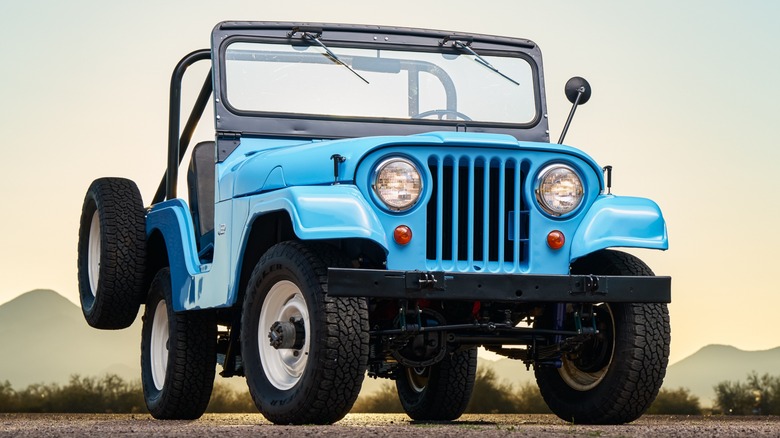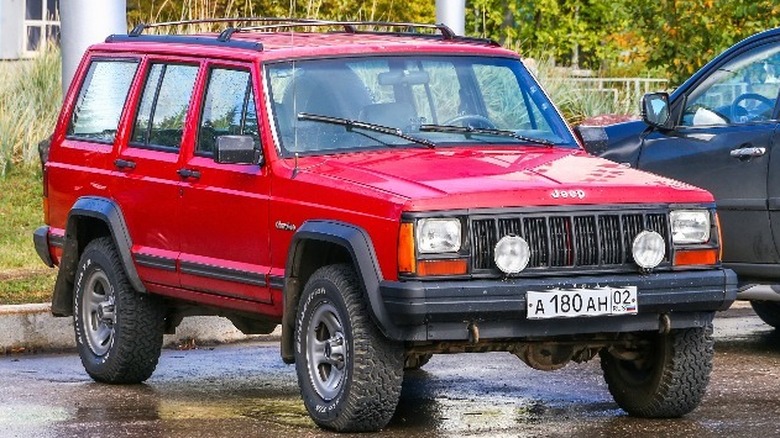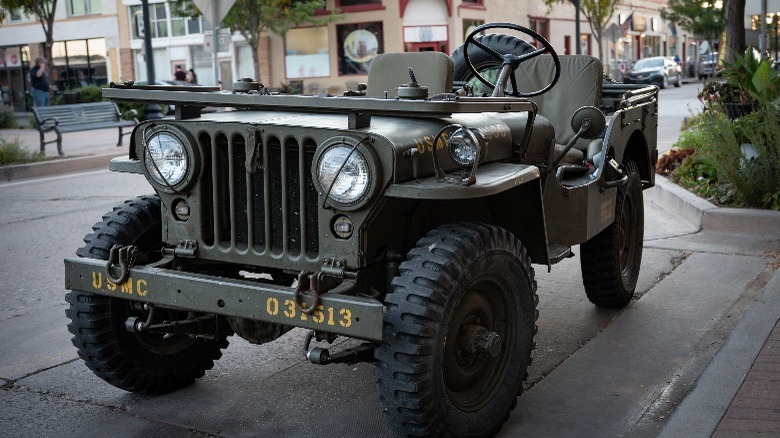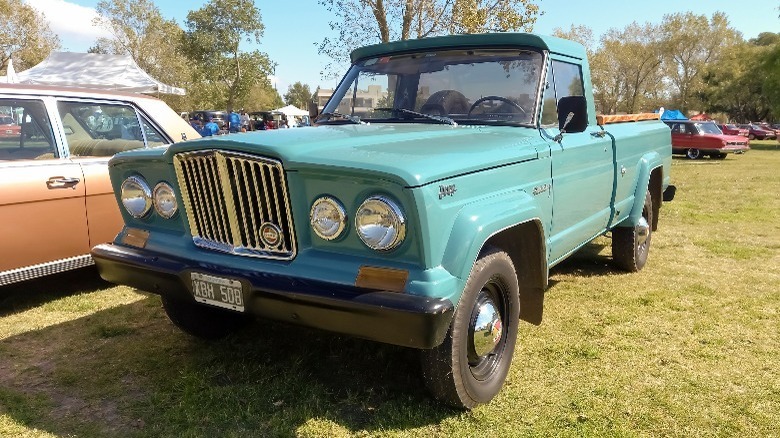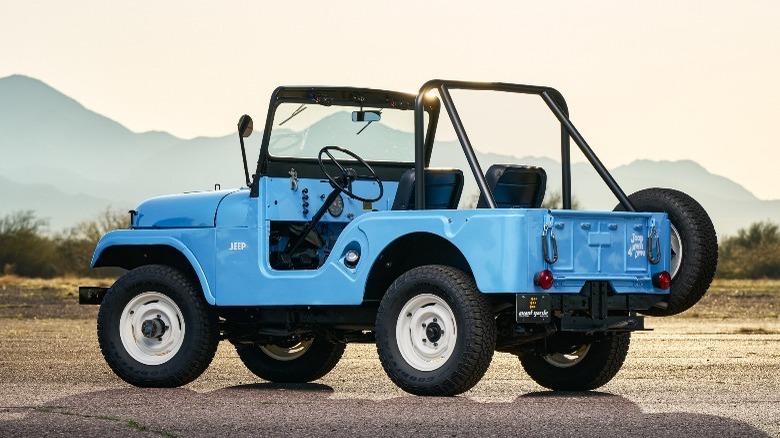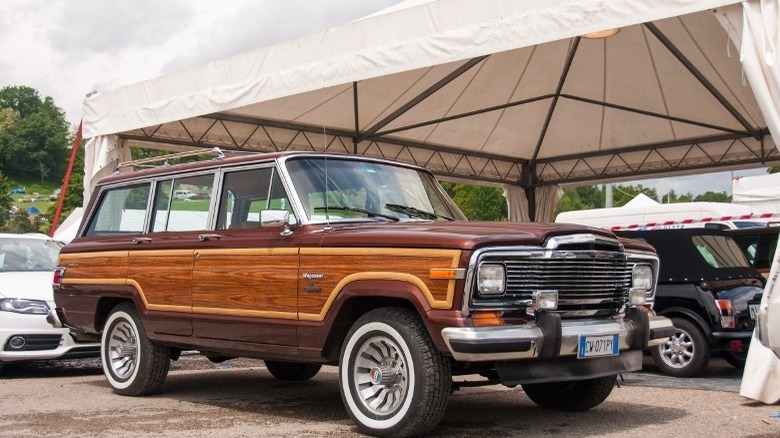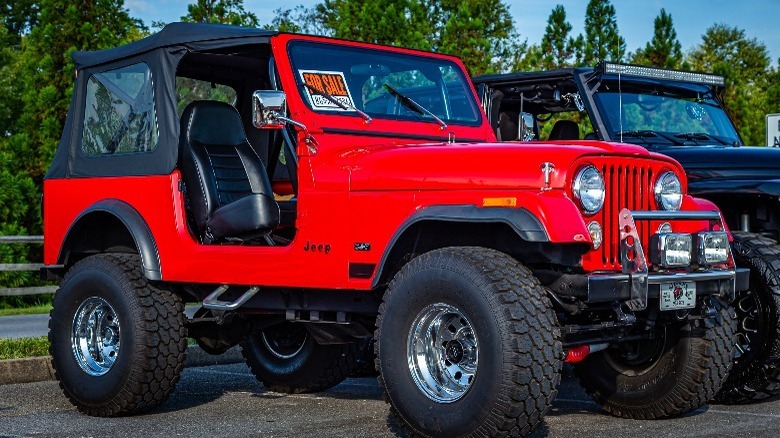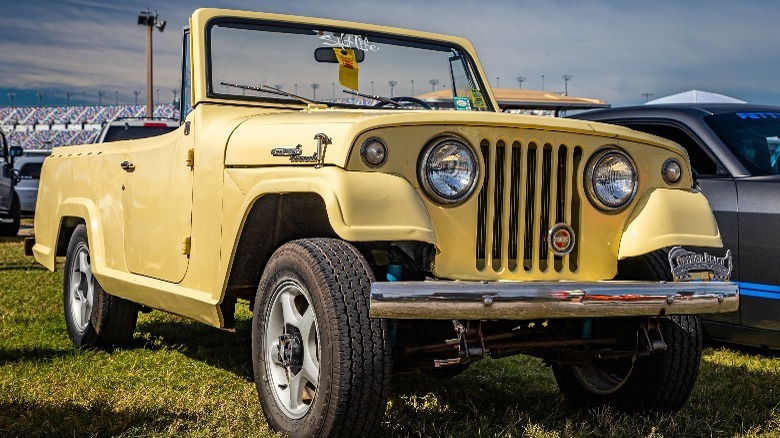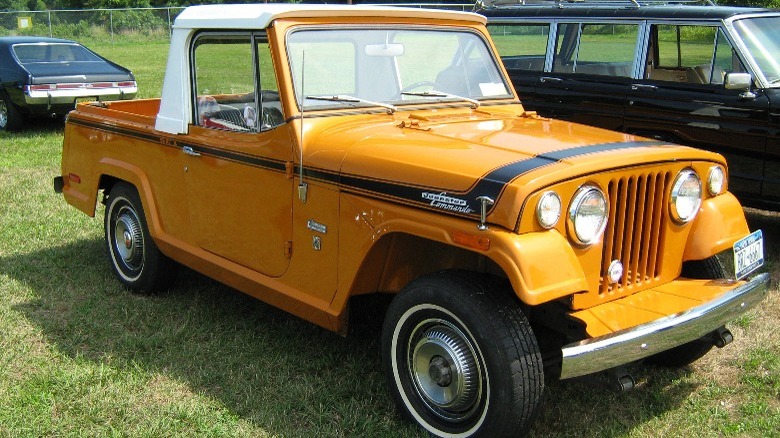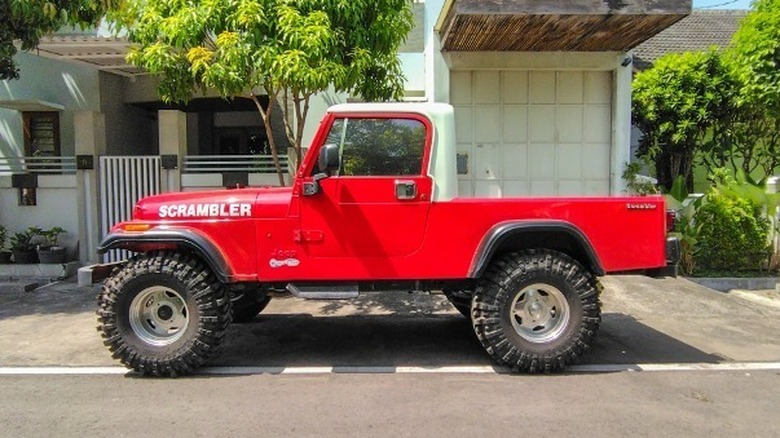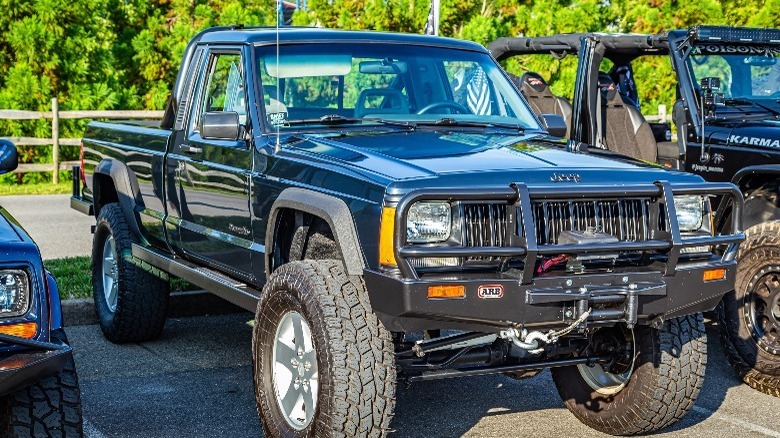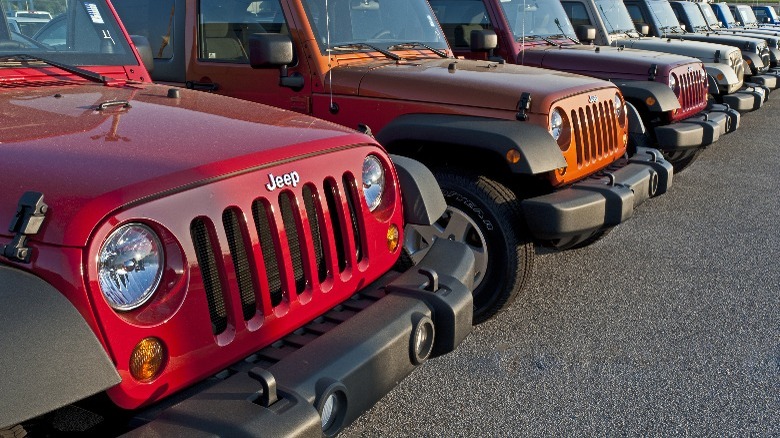10 Of The Most Collectible Jeeps Worth Buying (If You Can Find One)
Jeeps are some of the most iconic cars ever made. Jeep's 80 plus year long history began in 1941, with the release of the first ever Jeep — the Willys MB — which was the result of the U.S. military's search for a compact off-road companion. Since then we've seen a number of releases from the company, each one having its own source of appeal to Jeep's cult-like following. Still, not all Jeeps are created equal — some models have managed to cement themselves as icons and become collector's dreams.
From its military roots all the way to its civilian adaptations, Jeep has managed to produce cars reminiscent of its heritage. From the CJ-2A, which was the first civilian jeep ever manufactured, to the short lived but highly sought after Jeepster Commando, we'll be taking a look at some of these models and finding out why exactly they've managed to become perfect additions to any Jeep collection.
Cherokee XJ
The Jeep Cherokee XJ is an iconic vehicle that helped pave the way for the modern SUVs we know today. However, pinpointing exactly why the Cherokee has risen to icon status is not as straightforward as it may seem, but many attribute this to factors like its utility, affordability, and its cultural impact.
It was released in 1983 for the 1984 model year and at the time it was actually marketed as a sportswagon, as this was a time when SUVs weren't a major car variant. Despite the unusual marketing, Cherokee XJ was incredibly successful, selling 2.9 million units between 1984 and 2001, and its unique design inspired imitations from competitors like Ford and General Motors. It came in a couple of configurations, including two-door, four-door, all wheel drive, and rear-wheel drive.
The Cherokee XJ broke new ground, not only in terms of its design but also in its construction and fuel economy. Its top of the line unibody construction and off-road ability surprised many, especially given the original price. It was also incredibly durable and reliable — a classic example of a car that just won't give up.
CJ-2A
The first ever Jeep, the Willys MB, was originally manufactured by Willys Overland Motors as a light utility vehicle designed for the U.S.military to carry and transport equipment across war zones and rough terrains during the second World War.
The Willys MB was extremely successful as a military vehicle, and its design was replicated by a number of other manufacturers and even adapted by other military forces around the world. Capitalizing on this popularity, Willys adapted the original Jeep for civilian use and manufactured 214,760 units during its production run from 1945 to 1949. As the first civilian Jeep widely available after World War II, it retains the spirit of exploration and utility.
It was intended to be a suitable companion for farmers, ranchers, and for other industrial and agricultural uses. The CJ-2A has been repeatedly referred to as a workhorse on wheels, offering farmers and everyday consumers that legendary Jeep capability. It's an extremely key point in Jeep's history as it started off the legacy that we know today and as a result any remaining examples are highly collectible.
Gladiator SJ
After the major success of the Wagoneer, Kaiser-Jeep – which was the company formed as a result of the merger between Willys Overland and Kaiser-Frazer Motors — decided to try and establish itself in the pickup market. The Gladiator SJ launched in 1962 as a replacement for the Willys Jeep Truck and was built on the platform of the original Wagoneer, sharing the same front-end design as well as a powertrain. However, the Gladiator SJ also offered some of the most innovative features available in a standard pick up.
Jeep Gladiators offered a capable pickup option with off-road prowess, with Jeep promoting them as powerful and reliable work vehicles. This meant that even though it was classified a light pickup, it was still suitable for intensive tasks like towing but still small enough for everyday use.
Though the Gladiator was the perfect companion for more rugged and demanding use cases, its similarity to the Wagoneer meant it also came with a lot of the same creature comforts, making it a more refined and luxurious option than many of its counterparts. This was not the only thing that set it apart from the rest, as the Gladiator was the first 4x4 pickup truck from Jeep to come with the option of an automatic transmission.
CJ-5
With its strong ties to the original Willys MB, the CJ-5 is another one of the most iconic jeep models ever produced, even making an appearance on our list of the best Jeeps of all time. The CJ-5 debuted in October 1954 for the 1955 model year. The CJ-5 had a similar design language to the original CJ-2A and was pretty compact, but was still available with an inline 4, an inline 6, or a V6.
The CJ-5 was such a staple in Jeep's lineup that it was still in production even with the release of three newer models. It was just that hard to get rid of. This was because the CJ-5 was a big consumer favorite. In fact, it was in production from 1955 all the way till 1985, a whopping three decades, making it the longest produced Jeep in history.
There were multiple special editions produced over its 30 year run including the Renegade, the Super Jeep and the Golden Eagle, so there's definitely a CJ-5 for everyone. The CJ-5 saw the beginning of its demise once the CJ-7 was released, but it still was loved in the hearts of many and has been a favorite for generations.
Wagoneer SJ
Many have said that the Wagoneer was ahead of its time, with Jeep even calling it "the father of all luxury 4x4 SUVs." It was originally released as a station wagon but it eventually became what we know today as an SUV, and pioneered the idea of a luxury sport utility vehicle. Released in 1962 for the 1963 model year, the Wagoneer continued to be produced up until 1991, marking an impressive 29 year run.
It replaced the Willys Jeep Station Wagon at a time when a lot of other major competitors wanted a piece of the 4x4 market that Jeep had a strong hold on. This led to the introduction of the Wagoneer, which ended up being miles ahead of other four wheel drive vehicles that were on the market. Rather than the utilitarian look of other 4x4 vehicles, the Wagoneer adopted a more luxury car-like look that began the trend towards the SUV look that we are used to today.
It was also significantly bigger than its predecessor and came in a four-door variant which appealed to a new category of consumers -– families looking for an off-road capable vehicle. It was also pretty affordable at launch but if you're looking to one in good condition to your collection today, it'll likely run you upwards of $30,000.
CJ-7
Just like its predecessor the CJ-5, the CJ-7 bears a strong resemblance to the original Willys MB and the civilian CJ-2A. It maintains the same utilitarian, rugged look, giving you a good idea of its performance, but still possesses that signature stylish Jeep look. Though similar to the CJ-5, the CJ-7 was a breath of fresh air to the civilian jeep lineup, and it managed to introduce a number of new features, despite the fact that AMC was in a financially tight spot after its acquisition of Kaiser Jeep.
First of all, it came with a modern redesign, featuring more rectangular door cutouts in contrast to the rounder cutouts on the CJ-7, a subtle refresh to the headlight arrangement and of course, the extended wheelbase. The wheelbase of the CJ-7 was extended by about 10 inches which not only allowed for a roomier passenger cabin, but also made it possible to include the option for automatic as well as manual transmission. Just like the CJ-5, it had the option of a V8 engine, which in addition to its four-wheel drive system made it capable of handling any terrain.
Jeepster Commando
After the release of the CJ-2A, Kaiser-Jeep continued to pretty much dominate the 4x4 vehicle market with its CJ models. This led to an influx of four-wheel drive vehicle releases from competitors which included the Ford Bronco, the Toyota Land Cruiser, and the International Scout.
There was a huge encroachment on their market share happening and Jeep needed to act fast, but funding the development of a completely new release wasn't immediately feasible. So using a couple of parts they already had, Jeep managed to squeeze out the Commando for the 1967 model year, a four-wheel drive SUV that came in pickup, station wagon, convertible, and roadster models. After the acquisition of Kaiser-Jeep by AMC in 1970, the Jeepster was dropped, shortening its name to simply the Commando.
The Jeepster Commando had a relatively short run at Jeep, only being in production for six years, but this is actually what makes it a good contender for a lot of collectors. Not only did it have a limited run, but there are pre-AMC acquisition models of it available, which a lot of collectors value due to the close connection to the original Willys Brand
Jeepster SC-1 Sport Commando
If you're looking for something rare, this particular model of the Jeepster Commando is definitely one to consider. After AMC's acquisition, in a bid to cement the Commando in the sport utility market, Jeep released two specialty models — the Sport Commando SC-1 and the Jeepster Hurst Edition. These specialty models were also a response to falling sales of the Commando.
The Sport Commando was pretty much a sporty station wagon that came in a new Butterscotch Gold color with a sport stripe along the side and a standard V-6 engine under the hood. Sadly, sales of the Sport Commando were still disappointing. In an era where AMC was cleaning house and focusing on sales performance, this was the beginning of the end of the Jeepster.
The Sport Commando had an extremely limited run, and while the exact number isn't confirmed, some report that there were only around 300 units ever manufactured, so getting your hands on one would be quite a task. This rarity is however the major source of appeal for enthusiasts and having one in your collection will definitely give you major bragging rights.
CJ-8 Scrambler
The CJ-8 Scrambler was essentially the CJ-7 but with a longer extended wheelbase, making it more like a traditional pickup, so there was nothing particularly revolutionary about it in terms of technical innovations. However, what made the Scrambler so special was how it managed to add more functionality to an already beloved classic, while making it able to apply this functionality even in more difficult to maneuver terrains. This made it popular among a wide range of consumers, from farmers to adventurers.
The Scrambler name comes from one of the trim packages that the CJ-8 was offered in, which came with an orange and gold design on the side, lettering on the hood, and special wheels. The Scrambler has managed to garner a sort of cult following, and it's pretty easy to see why. Firstly, only a limited amount were produced between 1981 and 1986 – about 28,000 – making it an attainable but still rare prize for collectors. Also, it has enjoyed both celebrity ownership and pop culture relevance, with some popular owners being actor Leonardo DiCaprio and former President Ronald Reagan.
Jeep Comanche
The Jeep Comanche was essentially a pickup truck version of the Cherokee XJ that served as a replacement for the Scrambler. Around the early to mid-'80s, there was a rising trend of a preference for pickups over regular cars which was in part due to the functionality that comes with the addition of a truck bed. Japanese manufacturers like Nissan were making waves in the pickup market and AMC wanted a cut.
The Comanche debuted in 1985 for the 1986 model year, and during its six year production run over 190,000 units were produced, which is pretty impressive. Its popularity could be attributed in part to its price — with a starting price of $7,049 it was pretty affordable compared to other pickups on the market. It came in short- and long-bed configurations, with the long-bed being seven feet long.
This has been a long time fan favorite among Jeep enthusiasts as it offered a combination of a roomy, comfortable car cabin and the utility of a pickup truck, all wrapped in Jeep's signature 4x4 capability. This, coupled with a short lifespan and great aftermarket support makes the Comanche a desirable classic for collectors.
What makes a Jeep collectible anyway?
The word collectible could be a little ambiguous, so it's important to clarify exactly what we mean and how it informed our choices for this list. Collectible doesn't simply mean great or valuable — those are words usually attributed to collectible items but that's not exactly the defining factor. For an item to be considered a collectible it has to first of all be worth a lot more today than what it went for at launch. Applying this to cars, a collectible Jeep must firstly be worth more currently than it was during its production run.
Further, a collectible is usually an item that is no longer in production. Sometimes a brand or company may release a new limited item and market it as a collectible, but in reality the after-market worth of the item will usually have to be evaluated years after its production. There are a lot of factors that could make an item collectible. For this list, we're mainly focusing on Jeeps that stand out from the bunch for a couple of different reasons like historical significance, rarity, unique features, and innovations.
